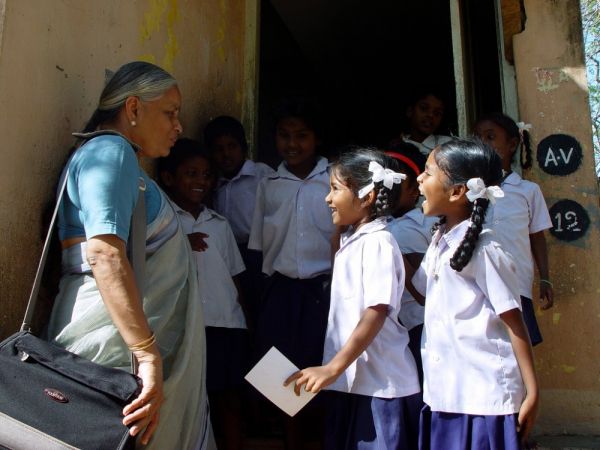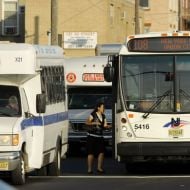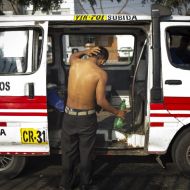How Strict New Rules About School Bus Safety Are Putting Kids at Risk

Today more parents in Chennai are forced to get their children to school through informal means. Photo credit: Brian Glanz
On a street in Adyar in south Chennai, two children wait on the street in blue and white uniforms. With large book bags on their backs and lunch baskets in their hands, they’re waiting for their ride to school. About 10 minutes later, a box-like brown van pulls up, filled with children sitting three to a row, bags squashed onto their laps. The new passengers clamber in and are whisked off in what is most likely a van that doesn’t have a permit to transport children to school.
It’s in a van like this in which 10-year-old E Dinesh was killed while returning home from school last week. He was nearly home when he stuck his head out of the window and was hit by a passing vehicle. Police later said the accident could have been averted if the van had bars on the windows and a conductor to keep an eye on the children, as the new rules for formal school vans mandate.
These rules came into effect after six-year-old Shruthi Sethumadhavan fell through a hole in the floor of her school bus and was killed in July 2012. The government norms include bars across windows and individual seats belts, lowering the seats for children, installing emergency exits and hiring a qualified attendant to chaperone. Vehicles transporting children also have to have to get their “fitness certificates” renewed every six months.
Despite the rules, the accidents continue. Last month, 14-year-old J Deepak died when the van bringing him home from school overturned at a curve on a flyover. Other students said the driver was talking to another motorist on a bike. Police later found that the driver was a 17-year-old. In India, one cannot get a learner’s permit until they turn 18.
Schools that run vehicles have made modifications to vans and buses, but private vans continue to flout the norms. The transport department and police too have impounded a few vehicles that did not follow the rules. However, the strict rules have in some ways compounded the problem since most schools no longer want to take on the responsibility of transporting children in their own buses.
Since the new rules came into effect in May, many schools have reduced the number of vehicles they operate. A report in the Times of India quoting data from the State Transport Authority says that city schools operated 2,297 buses in April. That figure dropped to 1,812 on May 1.
As a result, parents, usually in groups of 15 or 20, are hiring more private vans like the one Deepak and Dinesh were travelling in. “As more regulations were brought in, many schools stopped running school buses. So parents are now dependant on private operators. This dependence is likely to increase,” says D C Elangovan, secretary of the Federation of Associations
of Private Schools in Tamil Nadu. “It is not practical to expect schools to check if private vehicles that students travel in are safe.”
Yet less than 50 percent of vehicles transporting children to school have the required safety measures. Of the 10,000 vans registered with the Tamil Nadu Van Owners’ Association, more than 7,000 are in Chennai. “About half the vans in our association have made the changes required by the government. Many of these vans transport children to and from school, apart from ferrying wedding parties and tourists the rest of the time. We have asked all vans to install grills and emergency exits to ensure students’ safety, but some of these modifications may not suit adults who also use the vans,” says association president V Vairasekar. “This could affect van drivers’ earnings.”
The day after Dinesh was killed, regional transport officers from south Chennai conducted checks outside schools in Adyar. Outside one school, they stopped three van drivers who were talking on their cellphones while driving children to school. Two more drivers were stopped for running private vehicles as school vans. But such checks usually lose steam after a few weeks. And van drivers alone do not comprise the problem in its entirety. A combination of busy parents who don’t have time to drive their children to school, van drivers trying to earn as much as they can per seat, schools admitting more children than they have space for, and officials turning a blind eye to safety all share some of the blame.
Often parents enroll children in schools far from home and then find that there is no way to get their children to and from school. The van drivers charge between Rs 800 and Rs 2,000 a month, depending on the distance. The vans are built for 12 adults, but can carry 20 children.
Many more than that get squeezed into many of the vans, however. “In reality, 30 children are packed into a van,” says Shanthi Kamalasekaran, who drives her teenaged son to school after the driver of the van in which he travelled took in too many children. “The drivers flout rules because no one questions them. Many parents aren’t aware of the overcrowding because they don’t ask their children about the van, the driver or the attendant.”









